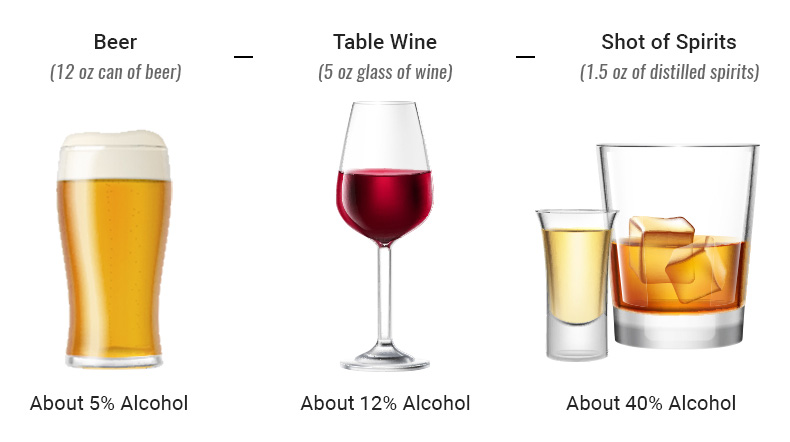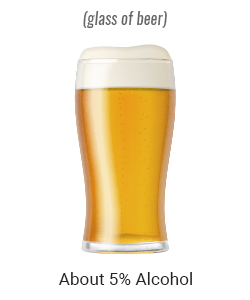Many people have heard of BAC levels, and what can happen if they’re too high and law enforcement gets involved, but not everyone understands how the process works. BAC levels are used to determine if a person should be able to operate a motor vehicle legally. How this determination is made consists of several parts and processes. this guide will explain what BAC is, why it’s important to know your level before making decisions, and what the consequences of some of those decisions might be.
What is BAC?
Blood alcohol content or blood alcohol concentration is a means to measure the amount of alcohol present in a person’s bloodstream. If a person has a BAC of .10% that means that a person’s bloodstream contains one part alcohol for every 1000 parts blood.
When a person consumes alcohol, it is broken down into sugars in the bloodstream. How much a person drinks, as well as other factors, determines how quickly the alcohol is broken down and the effects it has on the person. A person’s system can only handle so much alcohol before it is affected by its presence. This is called intoxication. For some people, it could take the form of slurred speech and wobbly movement, while for others, they don’t look or act intoxicated, even if their BAC is above legal limits.
From a legal standpoint, anyone who has a BAC over 0.08% is legally prohibited from driving. A person’s fine motor skills and reaction time become impaired at this level, and this can be dangerous when operating a motor vehicle. If a law enforcement official suspects a driver is impaired, the officer can perform a series of tests to help determine if a crime has been committed.
Defining “One Drink”
The definition of the term “one drink” can vary depending on several factors. First, a standard drink size varies depending on the type of alcohol and the alcohol content:
- 12 oz can of beer contains about 5% alcohol
- 5 oz glass of wine contains about 12% alcohol
- 1.5 oz of distilled spirits contains about 40% alcohol

When you examine the amounts above, you’ll see that a can of beer, a glass of wine, and a cocktail are equivalent to “one drink” based on their alcohol content. It takes much less of the distilled spirits to count as a single drink because of the elevated alcohol content. Three people of the same age and body type are drinking, but one is drinking beer, one is enjoying a glass of wine, and the other is having scotch on the rocks, the wine drinker is consuming much more alcohol than the beer drinker, and the scotch drinker is consuming even more, even though the can contains much more liquid. This is why, for some, “just one drink” could be enough to increase their BAC to illegal levels.
How Much Alcohol is in Your Blood?Our Calculator Can Help
Start Here
Body Weight In Pounds
Beer 12oz
- 5% ABV
Wine 5oz
- 12% ABV
Liquor 1.5oz
- 40% ABV
Time Since First Drink
Your BAC is approximately:
? %Depending on your blood alcohol content, you can experience different side effects. Some of those side effects can include (but not limited to):
- Shorter attention span
- Lack of fine motor skills & coordination
- Impaired judgement
- Loss of memory
- Delayed motor skills
- Balance problems
- Blurred vision
In most states, anything over .08% BAC is against the law and is also dangerous for you and other drivers on the road. You can use our calculator to also increase the time in hours and see how long the estimate will take for you to get to a 0% BAC level.
Variables that Affect Your BAC (Variables = Factors)
There are several variables that can affect your BAC level.
- Gender: Females tend to have higher BACs than men. Even if a male and female are the same weight and height and drink the exact same amount of the same drink, the female will have higher blood alcohol content. This is due to alcohol being dispersed in body-water and women having less water content in their bodies than men. Women may also tend to have less of the enzyme in their stomach that breaks down alcohol than men do.
- Weight : The more a person weighs, the more water retained in the body. The water dilutes the alcohol, which causes a lower BAC level.
- Age: The older you get, the greater the effect of alcohol on your body.
- Rate of Consumption: The faster you drink, the faster your BAC will increase.
- Food: Drinking on an empty stomach will increase your BAC faster than if you drink while or after eating.
How Can a BAC Calculator Help You?
Knowing your blood alcohol concentration can help you make smart decisions when it comes time to leave the bar, restaurant, or friend’s house. A BAC calculator can help you determine if you are possibly at, near, or over the legal BAC limit.
Most calculators require that you enter your gender, and then your weight. This is no time to be proud, you need an accurate reading, so even if you only look like you weigh 120 pounds, if you actually weigh 135 you need to enter that number. Then, you have to choose the type of alcohol you’ve been consuming and finally how long it’s been since your first drink. The calculation will let you know your current BAC. You can use this information to decide whether to drive home, call a cab, or wait a little while and check again. Ultimately, it can help prevent you from driving while being under the influence, an act that can have legal and lasting consequences.
What are the BAC Limits in Each State?
 In all 50 states and the District of Columbia, 0.08% is the legal BAC limit. Most states have a “zero tolerance” level for underage drinking set at 0.02%, but New Jersey has a limit of 0.01%, while Alabama, Arizona, the District of Columbia, Illinois, Maine, Minnesota, North Carolina, and Oregon have a literal zero tolerance level of 0.0%. Aggravated DUI, a charge imposed when a driver’s BAC is much higher than 0.08% occurs in every state except for Alabama, Maryland, Mississippi, Montana, Oregon, and Vermont. For the rest of the US, .15% or higher could result in an aggravated DUI charge.
In all 50 states and the District of Columbia, 0.08% is the legal BAC limit. Most states have a “zero tolerance” level for underage drinking set at 0.02%, but New Jersey has a limit of 0.01%, while Alabama, Arizona, the District of Columbia, Illinois, Maine, Minnesota, North Carolina, and Oregon have a literal zero tolerance level of 0.0%. Aggravated DUI, a charge imposed when a driver’s BAC is much higher than 0.08% occurs in every state except for Alabama, Maryland, Mississippi, Montana, Oregon, and Vermont. For the rest of the US, .15% or higher could result in an aggravated DUI charge.
Typical Tests Used to Test Your Blood Alcohol Concentration Levels
- Field Sobriety Tests: If you’re pulled over under suspicion of DUI or DWI, the officer can request that you complete a series of tests to determine whether or not you’re impaired. These tests include activities such as touching your finger to the tip of your nose, walking in a straight line with your arms extended, following a pen or light with just your eyes, and standing on one foot with your arms at your sides and then extended. Those who are impaired by alcohol could have issues performing these activities.
- Breathalyzer: Breathalyzers are lightweight and portable, making them the go-to tool for law enforcement when DUI is suspected. Although some breathalyzers can be problematic, those which run on fuel cell sensors are considered accurate enough for prosecutorial purposes. The breathalyzer measures the amount of alcohol in a person’s breath as it passes through the lungs. Individuals can also purchase breathalyzers. They aren’t as accurate as the tools law enforcement use, but they are accurate enough to help a person make a safe decision about driving after drinking.
- Blood Test: A person must give permission for a blood test to be conducted. Legally, you are within your rights to refuse to submit to a blood test to determine your BAC level. However, those who refuse often face stiffer penalties such as license suspension, increased jail time, and higher fees. Although a blood test is more accurate than a breathalyzer or urine test, mistakes and errors can occur. For example, the vials could get mixed up in the lab, or the blood could coagulate or become otherwise tainted.
- Urine Test: Urine tests are another method used to measure a person’s BAC. However, these tests are considered even less accurate than blood tests and field sobriety tests. For one, they are invasive and cannot be completed during a traffic stop. Another issue is that, because alcohol can take up to two hours to show up in urine and remains in the system for up to 24 hours, it’s hard to determine if a person’s BAC was above the legal limit at the time of the stop. Finally, many urine exams cannot distinguish alcohol consumed by a person from the presence of alcohol from other origins such as paint, makeup, food, and certain hygiene products.
- Hair Tests: Hair testing isn’t accurate because traces of alcohol can stay in hair for up to 90 days. This would make it impossible to determine if a person was impaired at the time of a traffic stop.
Sources:
-
https://www.bactrack.com/blogs/expert-center/35040709-factors-that-affect-bac
**This Blood Alcohol Content Calculator is intended for education use only. These are estimates based on gender, weight, alcohol percentages and time frames. This is not legal advice on BAC percentages. There are many variables that can also affect these percentages like medications you may be taking, metabolism rates, what you ate before you started to drink. There are many other variables that can affect BAC%, which is why this is a tool to only be used for educational purposes.

